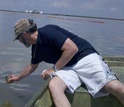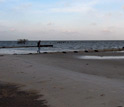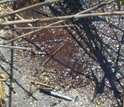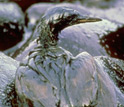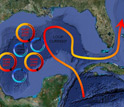News Release 10-088
Gulf Oil Spill: NSF Awards Rapid Response Grant to Study Microbes' Natural Degradation of Oil
Do manufactured dispersants interfere with microbes' natural oil-dispersing ability?
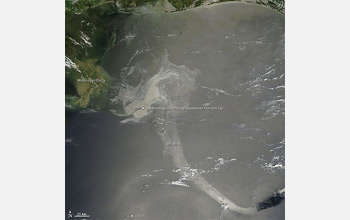
Oil that has reached the Gulf's surface glints in mid-day sunlight.
May 21, 2010
This material is available primarily for archival purposes. Telephone numbers or other contact information may be out of date; please see current contact information at media contacts.
To understand how the use of dispersants impacts the degradation of oil in the Gulf of Mexico, the National Science Foundation (NSF) has awarded a rapid response grant to scientist David Valentine of the University of California at Santa Barbara and colleagues.
The massive release of oil from the Deepwater Horizon incident on April 20, 2010, has led to an unprecedented use of oil dispersants, which include a mix of surfactant compounds designed to dissolve oil and to prevent slick formation.
"Dispersants are being sprayed aerially and added at the sea-floor, and the total usage is likely to exceed one million gallons before this is over," Valentine says.
Previous research has shown mixed effects, however, of these surfactants on degradation of oil. Little is known about the effects on the ability of microbes that live in the Gulf to naturally degrade the hydrocarbon compounds found in crude oil.
Crude oil consists of thousands of different compounds, with different chemical structures.
Some evaporate easily, some do not. Some dissolve in water and some do not. Some are easily degraded by microbes and some are not.
According to Valentine, many different microbes eat oil, but each does so with a different preference for which compounds they attack, like people at a buffet.
Many microbes also produce their own unique surfactants to help corral the oil into a preferred form.
The team seeks to understand how the dispersants added to the spill will interact with natural compounds produced by microbes, and how this will impact the ability of different microbes to break down the oil.
"This research will use a combination of chemical and biological tools to track changes in the composition of the oil, changes in the microbes in the Gulf, and changes in the amount of surfactant present, to determine the impact of these dispersants on oil biodegradation," says Don Rice, program director in NSF's Division of Ocean Sciences, which funded the rapid response award.
Valentine and colleagues are studying how the different dispersants impact the microbes, looking to the molecular patterns of hydrocarbon loss to find answers.
The scientists are acquiring samples of fresh slick oil from near the Deepwater Horizon wellhead; weathered slicks from the offshore environment; and beach tar samples.
Hydrocarbon-degrading bacteria differ in their substrate preferences, as well as in their response to surfactants, which will play an important role in determining the rate and extent of biodegradation of the oil spill.
"We're researching this real-world spill," Valentine says, "by simultaneously investigating oil composition, the microbes, and the dispersants.
"We think the dispersants may impact the microbes through interference with the action of their natural dispersants."
This NSF grant is one of many Gulf oil spill-related rapid response awards made by the federal agency. NSF's response involves active research in social sciences, geosciences, computer simulation, engineering, biology, and other fields. So far, the Foundation has made more than 60 awards totaling nearly $7 million.
-NSF-
-
Scientists collect Gulf of Mexico oil samples for study of the oil's degradation process.
Credit and Larger Version -
Along with flotsam and jetsam, oil lines beaches along the Gulf of Mexico.
Credit and Larger Version -
David Valentine and colleagues study oil from the Deepwater Horizon spill.
Credit and Larger Version -
The Gulf's wildlife is increasingly being affected by the spill.
Credit and Larger Version -
Oceanographers are carefully watching the Gulf's Loop Current, which may carry oil far afield.
Credit and Larger Version
Media Contacts
Cheryl Dybas, NSF, (703) 292-7734, email: cdybas@nsf.gov
The U.S. National Science Foundation propels the nation forward by advancing fundamental research in all fields of science and engineering. NSF supports research and people by providing facilities, instruments and funding to support their ingenuity and sustain the U.S. as a global leader in research and innovation. With a fiscal year 2023 budget of $9.5 billion, NSF funds reach all 50 states through grants to nearly 2,000 colleges, universities and institutions. Each year, NSF receives more than 40,000 competitive proposals and makes about 11,000 new awards. Those awards include support for cooperative research with industry, Arctic and Antarctic research and operations, and U.S. participation in international scientific efforts.
Connect with us online
NSF website: nsf.gov
NSF News: nsf.gov/news
For News Media: nsf.gov/news/newsroom
Statistics: nsf.gov/statistics/
Awards database: nsf.gov/awardsearch/
Follow us on social
Twitter: twitter.com/NSF
Facebook: facebook.com/US.NSF
Instagram: instagram.com/nsfgov



